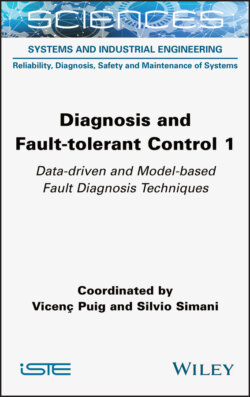Читать книгу Diagnosis and Fault-tolerant Control 1 - Группа авторов - Страница 17
I.7. Data–driven approaches to robust FDI
ОглавлениеIn previous sections, we have seen that model-based FDI methods formally require a high accuracy mathematical model of the monitored system. The better the model is as a representation of the dynamic behavior of the system, the better the FDI performance will be. It is difficult to develop a highly accurate model of a complex system and hence the interesting question is: “what is a reasonable model to enable good performance in FDI to be guaranteed?”.
It would be attractive to develop a robust FDI technique which is insensitive to modeling uncertainty, that is, so that a highly accurate mathematical model is no longer required. However, in order to design a robust FDI scheme, we should have a description (i.e. some information) about the uncertainty, for example, its distribution matrix and spectral bandwidth, and so on. Furthermore, this description should provide assistance for a robust FDI design, that is, it can be handled in a systematic manner. This book will show how a typical uncertainty description makes use of the concept of “unknown inputs” acting upon a nominal linear model of the system. These unknown disturbances describe the uncertainties acting upon the system but disturbance distribution matrices are assumed to be known since they can be estimated by identification schemes.
It is clear that disturbances and faults act on the system in the same way, and thus we cannot easily discriminate between these excitation signals unless we know the structure of the disturbance distribution matrix. Once the disturbance distribution matrix is known, we can generate the residual with the disturbance decoupling (robust) property, that is, the residual is decoupled from the disturbance (uncertainty). The robust residual can then be used to achieve reliable FDI and FTC.
The theories underlying robust FDI approaches have been very well developed, but for real applications the following problems remain unsolved:
– estimation of the reliable model for the monitored process;
– modeling accuracy of the real uncertainty by means of identified disturbance terms when no knowledge of the uncertainty is available;
– estimation of the disturbance terms and the structure of distribution matrices.
This book addresses these unsolved problems. Some simulation and real examples are given to test some of the theoretical results. These problems have to be addressed, otherwise the application domain of the disturbance decoupling approach for robust FDI is very limited. In fact, few researchers and contributions have presented the application results of robust fault diagnosis to real processes.
As mentioned above, a primary requirement for model-based and disturbance decoupling approaches to robust FDI is that both the system model and disturbance distribution matrices must be known. It is interesting that, within the framework of international research on this subject, there have been few attempts to address the problem by means of the identification approach. This lack of information has obstructed the application of robust FDI in real engineering systems. Therefore, we present the research developments surrounding the joint estimation of system and disturbance matrices in order to solve the robust fault diagnosis problem.
Concerning the data-driven schemes developed and exploited throughout the book, when all observed variables of a dynamic process are affected by uncertainties, the parameter estimation task can be performed by the so-called errors-in-variables methods. On the other hand, equation error methods can be developed in the case of exactly known plant variables (Simani et al. 2000). It is worthwhile noting that less attention has been paid to errors-in-variables schemes.
Under these considerations, this book presents the robust FDI results concerning the description of monitored plants by means of equation error and error-in-variables identified models in the presence of variable uncertainties. Moreover, for the examples presented, estimates obtained by the proposed data-driven approaches and parameter estimates will be computed and compared.
